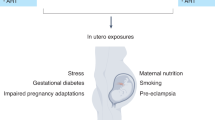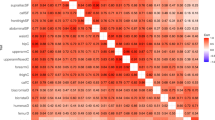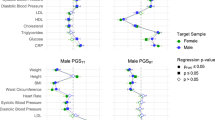Abstract
Background:
Animal experiments suggest that exposure to elevated levels of androgens during development by means of so-called hormonal programming causes metabolic aberrations at adulthood. An indirect strategy to address the possible importance of such an influence also in humans would be to study female dizygotic twins, presuming that those with a twin brother—due to diffusion of testosterone—have been exposed to higher androgen levels prenatally.
Design:
We have compared 8409 women with a male twin with 9166 women with a dizygotic female twin with respect to self-reported indices of anthropometry and metabolic aberrations at age 42 or older.
Results:
Body mass index (BMI), body weight and rate of dyslipidemia were moderately, but significantly, higher in women from opposite-sexed (OS) twin pairs; splitting for age revealed this difference to be present in those ⩾60 years of age only.
Conclusion:
The results (i) support the notion that comparisons of women with a twin brother with women from same-sexed twin pairs may be used to shed light on possible long-term effects of interindividual variations in early androgen exposure, and (ii) suggest that the effects of early androgen exposure on metabolism previously observed in animal experiments are of relevance also for humans.
This is a preview of subscription content, access via your institution
Access options
Subscribe to this journal
Receive 12 print issues and online access
$259.00 per year
only $21.58 per issue
Buy this article
- Purchase on Springer Link
- Instant access to full article PDF
Prices may be subject to local taxes which are calculated during checkout
Similar content being viewed by others
References
Barker DJ, Hales CN, Fall CH, Osmond C, Phipps K, Clark PM . Type 2 (non-insulin-dependent) diabetes mellitus, hypertension and hyperlipidaemia (syndrome X): relation to reduced fetal growth. Diabetologia 1993; 36: 62–67.
de Rooij SR, Painter RC, Holleman F, Bossuyt PM, Roseboom TJ . The metabolic syndrome in adults prenatally exposed to the Dutch famine. Am J Clin Nutr 2007; 86: 1219–1224.
Ismail-Beigi F, Catalano PM, Hanson RW . Metabolic programming: fetal origins of obesity and metabolic syndrome in the adult. Am J Physiol Endocrinol Metab 2006; 291: E439–E440.
Knickmeyer RC, Baron-Cohen S . Fetal testosterone and sex differences in typical social development and in autism. J Child Neurol 2006; 21: 825–845.
Baron-Cohen S, Knickmeyer RC, Belmonte MK . Sex differences in the brain: implications for explaining autism. Science 2005; 310: 819–823.
Abbott DH, Barnett DK, Bruns CM, Dumesic DA . Androgen excess fetal programming of female reproduction: a developmental aetiology for polycystic ovary syndrome? Hum Reprod Update 2005; 11: 357–374.
Nilsson C, Niklasson M, Eriksson E, Bjorntorp P, Holmang A . Imprinting of female offspring with testosterone results in insulin resistance and changes in body fat distribution at adult age in rats. J Clin Invest 1998; 101: 74–78.
Alexanderson C, Eriksson E, Stener-Victorin E, Lystig T, Gabrielsson B, Lonn M et al. Postnatal testosterone exposure results in insulin resistance, enlarged mesenteric adipocytes, and an atherogenic lipid profile in adult female rats: comparisons with estradiol and dihydrotestosterone. Endocrinology 2007; 148: 5369–5376.
Demissie M, Lazic M, Foecking EM, Aird F, Dunaif A, Levine JE . Transient prenatal androgen exposure produces metabolic syndrome in adult female rats. Am J Physiol Endocrinol Metab 2008; 295: E262–E268.
Eisner JR, Dumesic DA, Kemnitz JW, Colman RJ, Abbott DH . Increased adiposity in female rhesus monkeys exposed to androgen excess during early gestation. Obes Res 2003; 11: 279–286.
Abbott DH, Tarantal AF, Dumesic DA . Fetal, infant, adolescent and adult phenotypes of polycystic ovary syndrome in prenatally androgenized female rhesus monkeys. Am J Primatol 2009; 71: 776–784.
Dempsey PJ, Townsend GC, Richards LC . Increased tooth crown size in females with twin brothers: Evidence for hormonal diffusion between human twins in utero. Am J Hum Biol 1999; 11: 577–586.
Voracek M, Dressler SG . Digit ratio (2D:4D) in twins: heritability estimates and evidence for a masculinized trait expression in women from opposite-sex pairs. Psychol Rep 2007; 100: 115–126.
Cohen-Bendahan CC, Buitelaar JK, van Goozen SH, Orlebeke JF, Cohen-Kettenis PT . Is there an effect of prenatal testosterone on aggression and other behavioral traits? A study Comparing Same-Sex and Opposite-Sex Twin Girls Horm Behav 2005; 47: 230–237.
Cohen-Bendahan CC, Buitelaar JK, van Goozen SH, Cohen-Kettenis PT . Prenatal exposure to testosterone and functional cerebral lateralization: a study in same-sex and opposite-sex twin girls. Psychoneuroendocrinology 2004; 29: 911–916.
Resnick SM, Gottesman II, McGue M . Sensation seeking in opposite-sex twins: an effect of prenatal hormones? Behav Genet 1993; 23: 323–329.
Culbert KM, Breedlove SM, Burt SA, Klump KL . Prenatal hormone exposure and risk for eating disorders: a comparison of opposite-sex and same-sex twins. Arch Gen Psychiatry 2008; 65: 329–336.
Henderson BA, Berenbaum SA . Sex-typed play in opposite-sex twins. Dev Psychobiol 1997; 31: 115–123.
Loehlin JC, Martin NG . Dimensions of psychological masculinity-femininity in adult twins from opposite-sex and same-sex pairs. Behav Genet 2000; 30: 19–28.
Rose RJ, Kaprio J, Winter T, Dick DM, Viken RJ, Pulkkinen L et al. Femininity and fertility in sisters with twin brothers: prenatal androgenization? Cross-sex socialization? Psychol Sci 2002; 13: 263–267.
Lichtenstein P, Sullivan PF, Cnattingius S, Gatz M, Johansson S, Carlstrom E et al. The Swedish twin registry in the third millennium: an update. Twin Res Hum Genet 2006; 9: 875–882.
Lichtenstein P, De Faire U, Floderus B, Svartengren M, Svedberg P, Pedersen NL . The Swedish twin registry: a unique resource for clinical, epidemiological and genetic studies. J Intern Med 2002; 252: 184–205.
Orlebeke JF, van Baal GC, Boomsma DI, Neeleman D . Birth weight in opposite sex twins as compared to same sex dizygotic twins. Eur J Obstet Gynecol Reprod Biol 1993; 50: 95–98.
Acknowledgements
This study was sponsored by the Swedish Research Council (grants no 6178 and 12206), Torsten and Ragnar Söderberg's Foundation, Bertil Hållstens Foundation/Swedish Brain Foundation, the Swedish Brain Power Initiative, Novo Nordisk Foundation, the Swedish Diabetes Association Research Foundation and the Swedish Knowledge Foundation through the Industrial PhD programme in Medical Bioinformatics at the Strategy and Development Office at Karolinska Institutet. Funding for the STR has been provided by the Swedish Department of Higher Education.
Author information
Authors and Affiliations
Corresponding author
Ethics declarations
Competing interests
The authors declare no conflict of interest.
Rights and permissions
About this article
Cite this article
Alexanderson, C., Henningsson, S., Lichtenstein, P. et al. Influence of having a male twin on body mass index and risk for dyslipidemia in middle-aged and old women. Int J Obes 35, 1466–1469 (2011). https://doi.org/10.1038/ijo.2011.18
Received:
Revised:
Accepted:
Published:
Issue Date:
DOI: https://doi.org/10.1038/ijo.2011.18
Keywords
This article is cited by
-
Birth size and gestational age in opposite-sex twins as compared to same-sex twins: An individual-based pooled analysis of 21 cohorts
Scientific Reports (2018)
-
Does the sex of one’s co-twin affect height and BMI in adulthood? A study of dizygotic adult twins from 31 cohorts
Biology of Sex Differences (2017)
-
Effect of co-twin gender on neurodevelopmental symptoms: a twin register study
Molecular Autism (2016)



